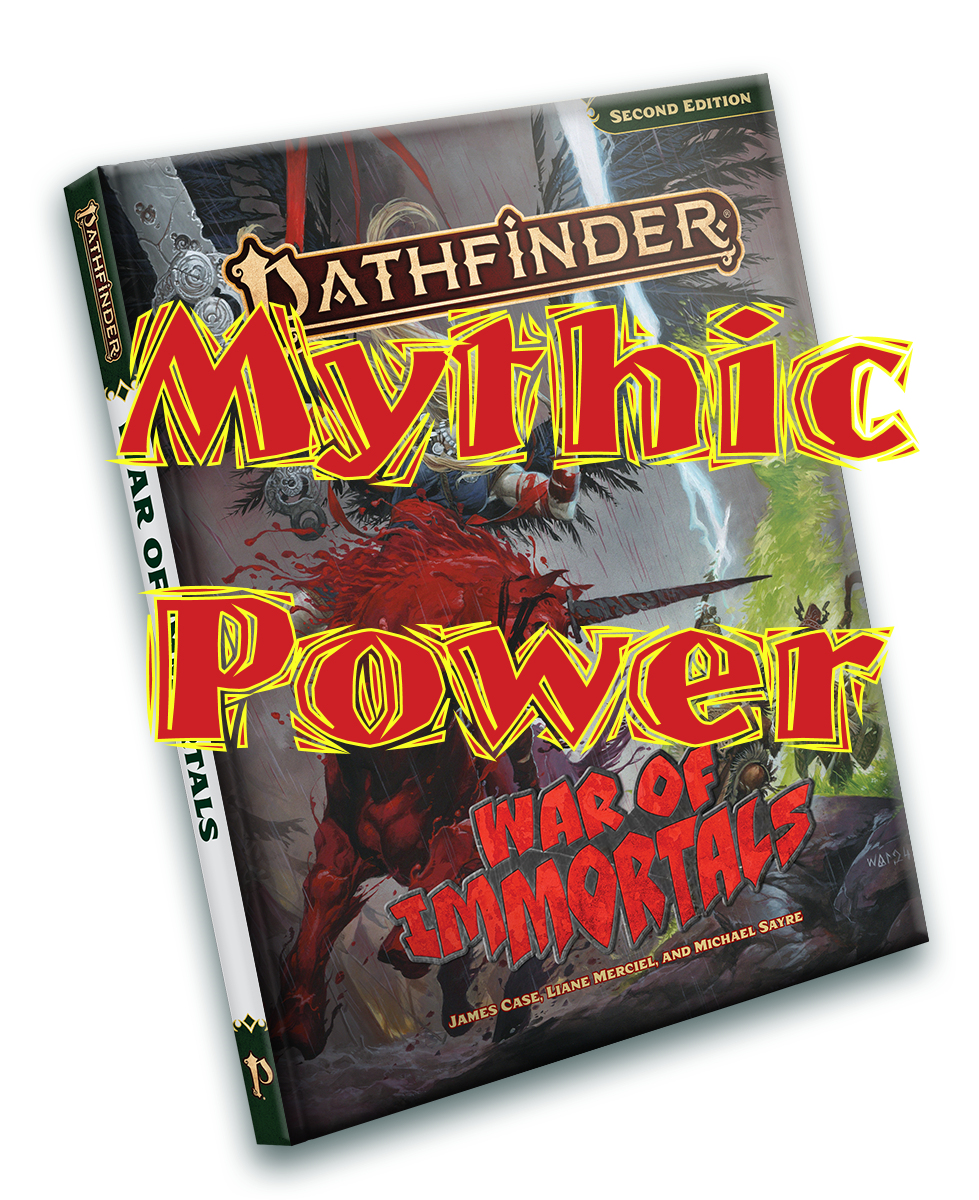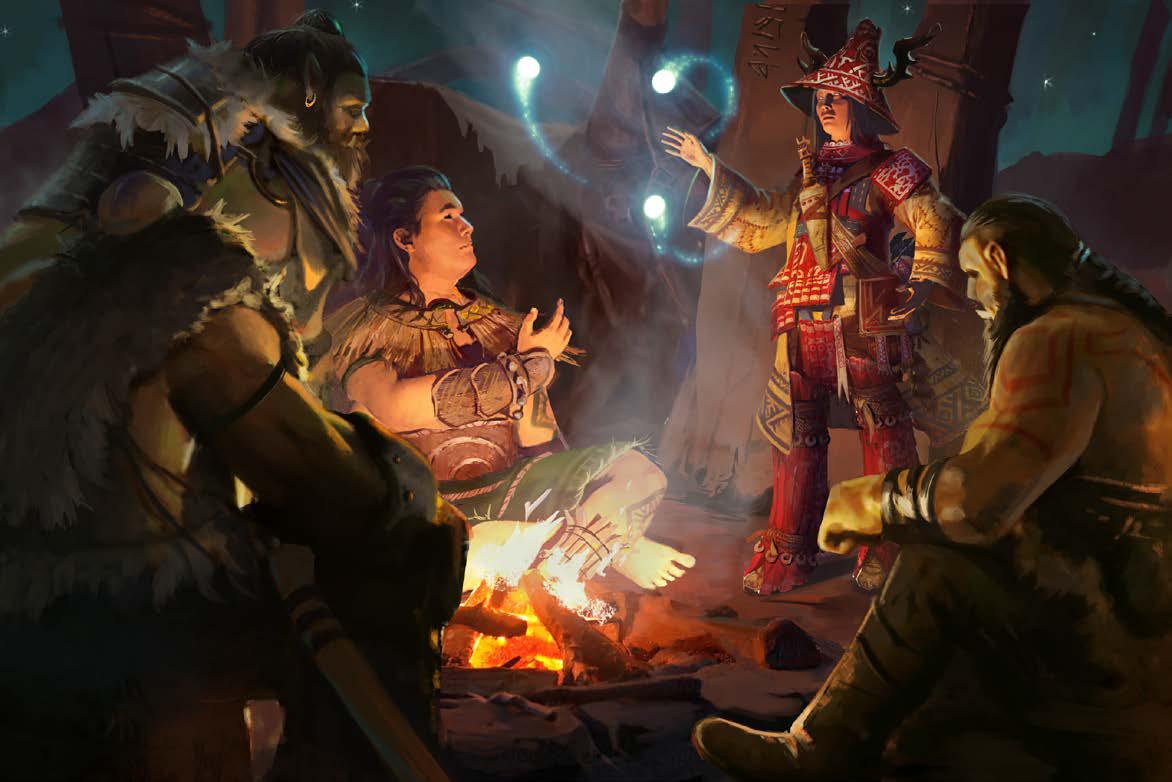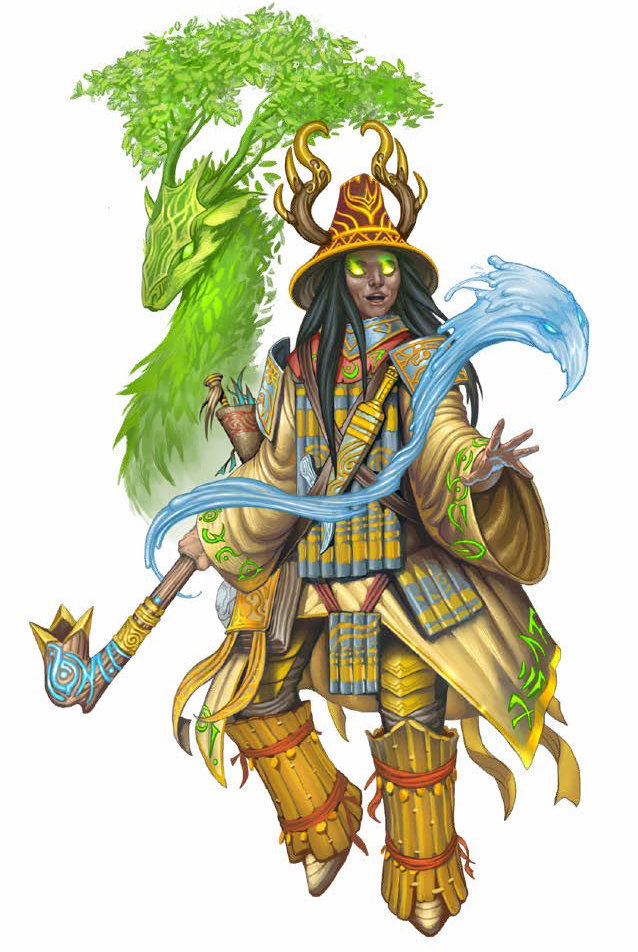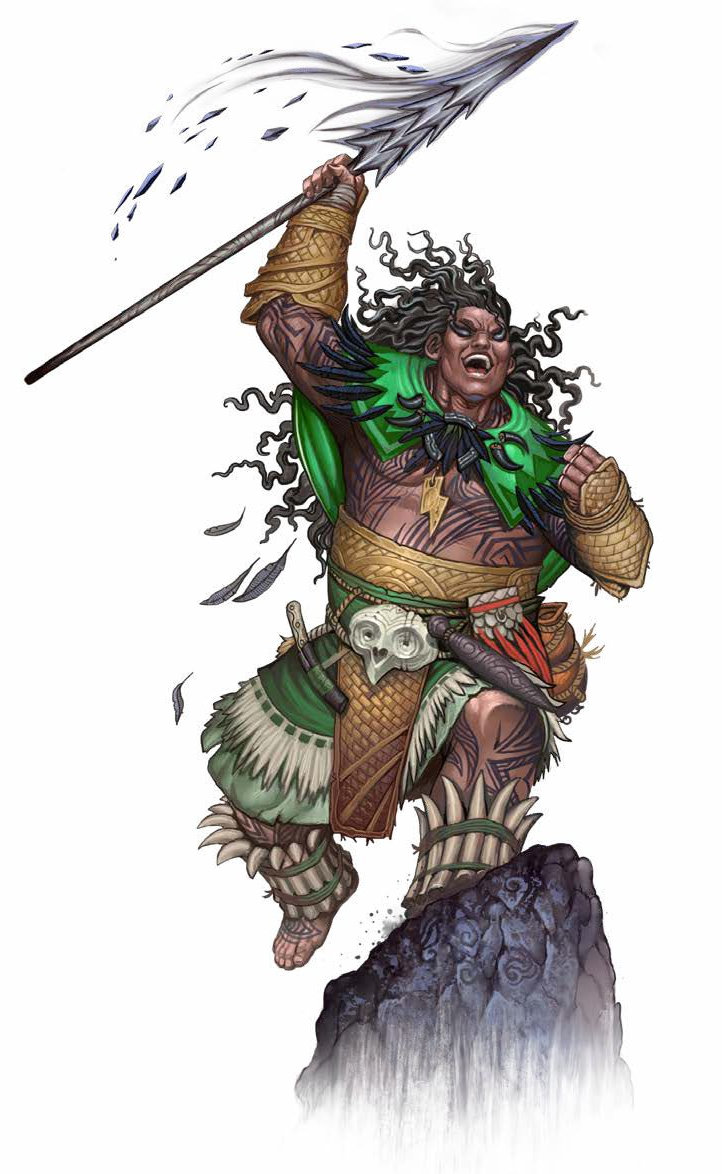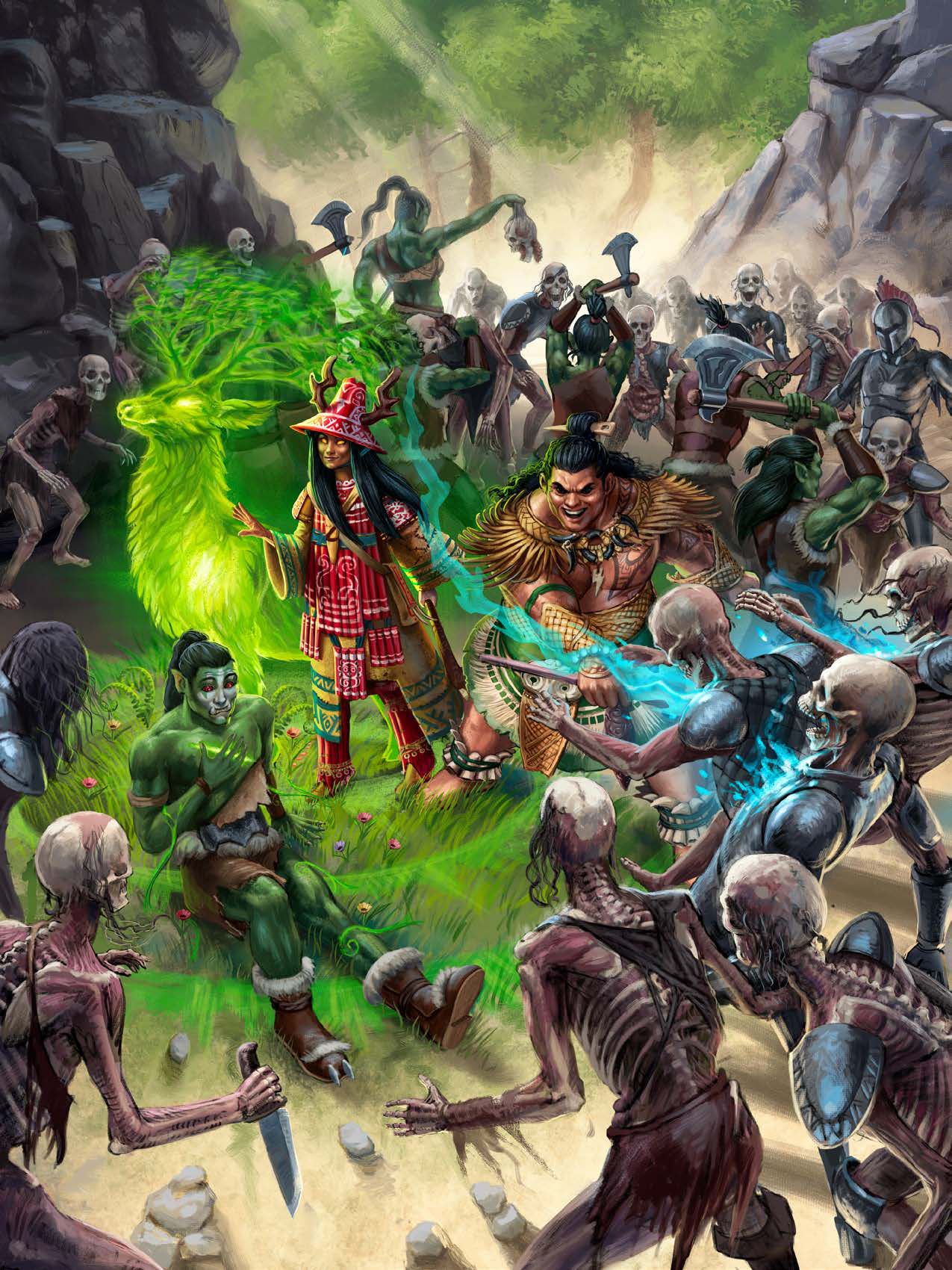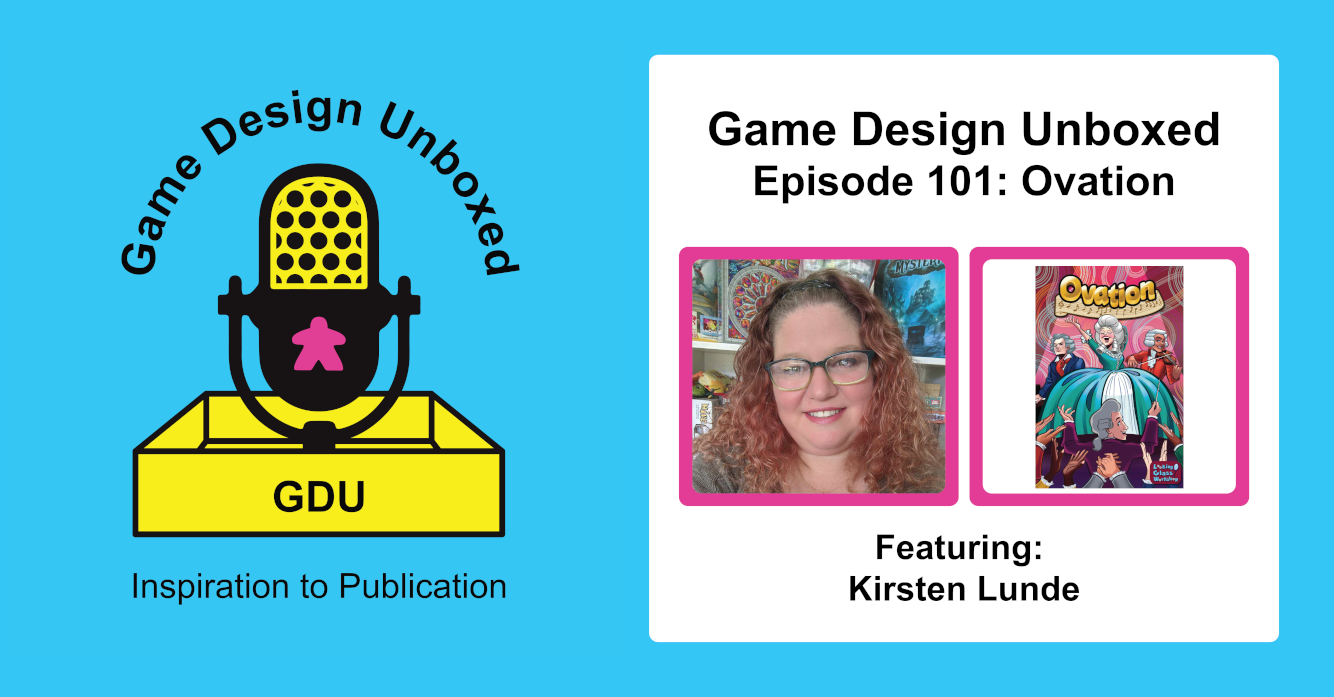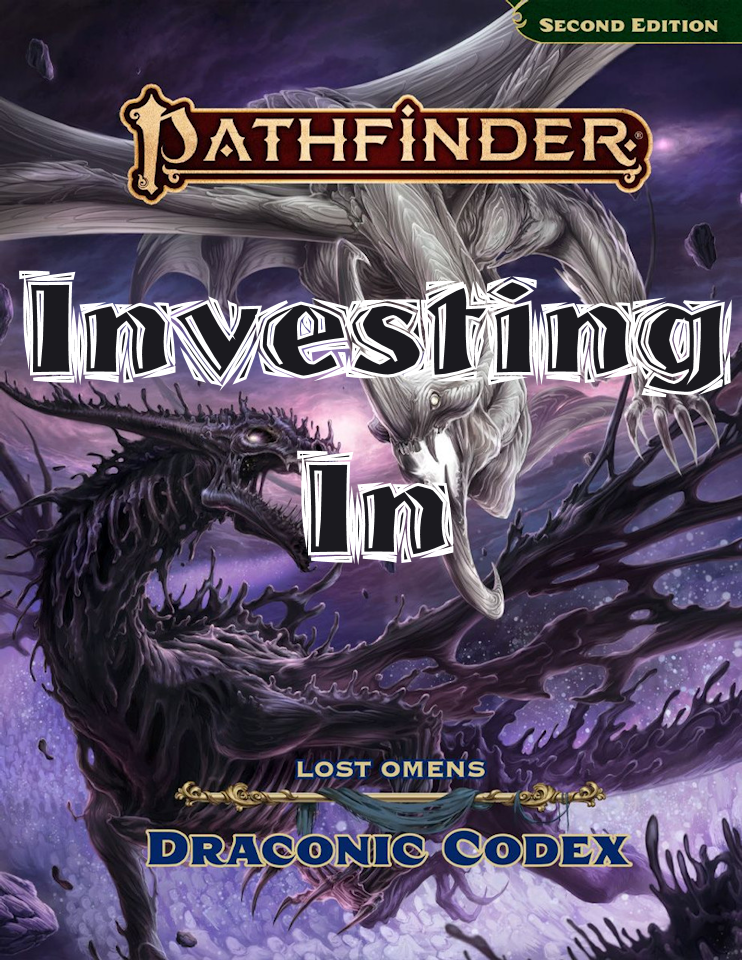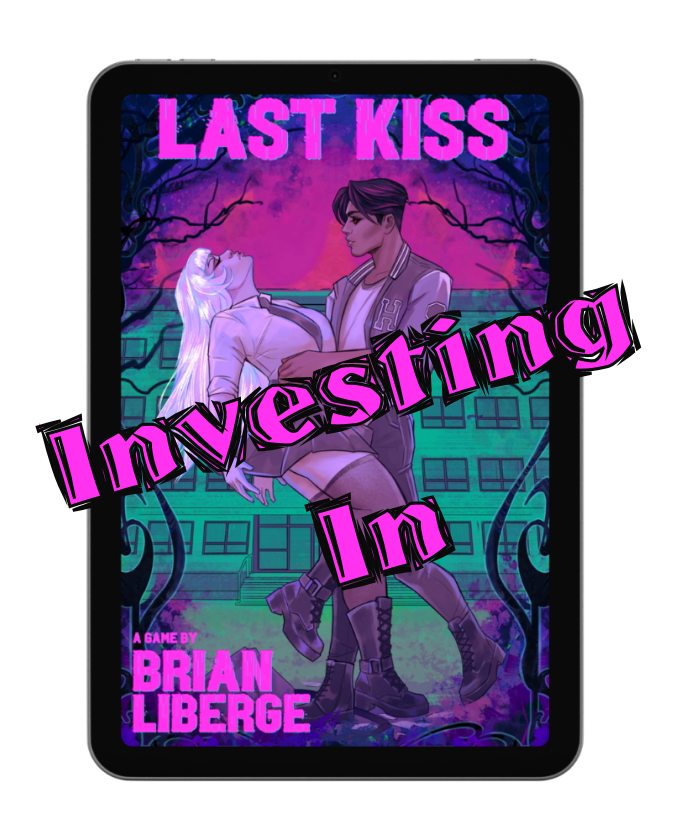“Mythic adventures take their inspiration from stories and legends that are drawn from folktales and storytelling traditions around the world. These tales use wordplay and rarefied prose to convey moral lessons and tell stories that often defy logic. Mythic heroes and villains, even at lower levels of play, possess fantastical powers that are unbound by physics, and their ability to impact the narrative of the game world is often much more profound than is typical for a PC or NPC.”1
You were already on a heroic journey, but now the story is truly mythic. It’s time for more War of Immortals, and was I ever excited to see what Mythic could be for Pathfinder2E. First, a shout out to the amazing authors, developers, artists, editors, and team on this book as it’s filled with amazing mechanics, great art, and so much great lore. James Case, Liane Merciel, and Michael Sayre all had Author credits with Michael also being Design Lead. What’s more, the amazing Avi Kool has Editing Lead credit. But of course, there are so many more adding their voice to this book so check out that credit page and you can also Meet the Authors on the Paizo blog!
I truly appreciate the Myths and Legends chapter doesn’t go right into mechanics. After so many new mechanics for our new classes, ancestries, archetypes, I think it’s quite helpful to reset with a bit of a breakdown of what the chapter entails. It’s very informative and literally provides information on what you might find, as well as the Narrative intent to be told with mythic stories (and characters) as well as the Tone that these adventures will take. The challenges are harder, the impact greater, and the implications of every decision can not only impact your destiny but that of everyone else and the entire world, even the universe. Some will feel a great responsibility to use this power wisely (we know that lesson) but there will be those abusing that power to their own selfish ends as well as various monstrous challenges of truly mythic proportions. I appreciate the Tone leverages metaphor as reality – words cutting like a knife and truly drawing blood – as well as real folktales and stories. I hadn’t heard of “The Soldier and Death” from Russia but now I have. I love those great stories of being a simple person, giving away food to a beggar or helping an old person in the woods, becoming a true start to great heroics because it shows that person was good, willing to sacrifice or help. In this case it was a soldier giving away his last biscuit to a beggar and getting something grand (well, mythic actually) in return.
Yes, there’s a quick reference then to the mechanics we’ll see later on. But first, we focus on what a GM – and even players – should understand about Telling a Mythic Story. It’s not just the GM writing the story after all, all players are helping write that tale! At first there is the Calling, which may happen at any level, helping you transition from the standard adventurer to the mythic. It might even be you were born with power, but it activates at a challenging time (attack on your town?) or heck even puberty (X-Men mutant style!). Over time you’ll face numerous Trials, and there’s great guidance here for you GMs, before reaching the Final Approach to the ultimate challenge. That Final Approach is perhaps getting through a monstrous horde or army, breaking into a castle/tower/dungeon, and then confronting the big enemy in the Ordeal. Again, great detail here for players to help frame up their goals and GMs to craft around it so do check it out. Finally, there’s the detail on Immortality, which is supported by 20th level mechanics. This is when the heroes become one with the universe, Gods, achieve the ultimate goal (a la closing the Worldwound), or move on to battles amongst the planes. This is that destiny that mythic legends are marching toward, and once again, there’s great guidance here like considering an in-game plot that interests you for your character and you can help achieve a great ending for your character with the GM. We all want the collaborative story we’re telling together to be truly memorable after all!
Okay, So the Mythic Rules Are
How that literally plays out? Well, the Mythic Rules gets into the real details. First, forget your Hero Points. You don’t have them anymore. You have Mythic Points, and you start every session with 3. Don’t use them that session? Well you lose them and start with 3 anew next time. So, use them. What do you use them for? Well you can spend one to reroll a saving throw, skill check, attack, etc. at a proficiency bonus of 10 + your level. Yep, you’re even better than Legendary. In fact, use it on a skill you don’t have Expert or up in, and you get to count as having such like if you need Thievery of Expert or Master to open a lock. But it’s more than that, because various abilities, usually acquired through feats, will also require these Mythics Points. But don’t fear, through Mythic Deeds you can get more over the course of a session, or the adventures in general. Usually these deeds are more tied to hazard, puzzles, and other noncombat scenarios, likely tied to the Calling of your mythic hero. Mythic monsters can have them too, but it’s more an associated challenge than simply fighting the monster. I’ll mention a few later when we get to those monsters! Specifically however, if you defeat a mythic opponent the one whose attack killed them gets 2 points and the rest of the party gets 1. I’m intrigued to see this difference set as that certainly hasn’t been the general rule around XP and treasure. You might also achieve something or make a truly epic sacrifice and the GM can rule giving you mythics points, but in general it’s by completing a deed for 3 points to each member in the party or doing something in line with your Calling, which nets you 1 point.
Have You Heard the Mythic Call?
But what are Mythic Callings? This is your purpose, well your character’s anyway. Maybe it was granted by your deity, maybe it’s what inspires you, maybe it’s born from that initial mythic deed where your power came to you. But you have one, and only one. Each grants you some native abilities, like a way to spend Mythic Points as well as Edicts and Anathema to follow. Following your edicts grants you a mythic point, but violating your anathema makes you lose all you currently have. This book gives us 11 Callings, but I can see more in the future, especially in any Mythic adventures they release. As an example, we get the Demagogue’s Calling. You speak from the soul and can use a mythic point when you Coerce or Make an Impression. The first time each day you critically succeed to Coerce someone who isn’t an ally, Create a Diversion with words, or Make an Impression on someone indifferent or worse, you regain a Mythic Point. Sure seems like someone who could cut you with words, right? Well their Edicts are to tell stories who haven’t heard them, and use words before weapons to resolve conflicts. Indeed, it is Anathema to interrupt someone telling a story or to use violence without trying to defuse the situation diplomatically first. It’s sure to create some challenge for parties, but almost every Anathema could. Like don’t like to hide knowledge or refuse a request to hunt a dangerous animal. The Thief’s Calling has an anathema about leaving treasure unattended! Be careful in Pharasman tombs, Thief! She’ll have words for you when you die.
You get some additional abilities to help prevent death though. Each mythic hero does get a new free-action ability called Rewrite Fate. It allows you to reroll a skill check or saving throw where you don’t like the result. You spend the mythic point and get to use that bonus of 10 + your level. It’s also a lot harder to kill a mythic hero. When you would die (i.e. dying 4 for most), you instead become doomed 1 and stabilize at 0 hero point. Get to doomed 4 and you’re truly gone. But the doomed value goes away as normal, decreasing a point when you get a full night’s rest. Even mythic heroes need their sleep, unless they trance, or they’re androids, or… Well, they still rest. You get it.
They Look Like Big, Good, Strong Feats, Don’t They?
Mythic Feats start at level 2 and go through level 10. You gain one at each even level and then at 12th level you consider your Path to Immortality, which is basically a Mythic Archetype. But first, let’s consider these low-level feats. Some require a specific Calling, like Hands that Unweave Disaster requires you to follow that thief’s calling. With this 2nd level feat, you can spend a mythic point to Grab an Edge with that mythic proficiency. So that’s 2nd level, your bonus would be 12 + ability score + any bonuses and that d20 roll. You can also do so when Disabling a Device as well. Rewrite Fate let’s you do the reroll for any skill check or saving throw result, so not exactly a bonus on the Acrobats to Grab an Edge, but it would help with the Disabling Device if it required Expert or higher. Maybe let’s consider the 6th level reaction Correct The Story. Didn’t like that your enemy got a critical attack or saving throw result? Well let’s spend a Mythic Point and have them reroll. They just get better, as you might expect. 10th level has 7 options to choose from as printed. Mythic Casting let’s you spend a Mythic Point as a single action. Then the next Cast a Spell action you take, your spell attack roll or DC uses your Mythic Proficiency instead of its normal proficiency. Mythic Strike is similar but for a weapon or unarmed Strike. Eyes That See Eternity is a single action and you get truesight for a minute as well as making all Perception checks with that mythic proficiency. At 10th level, your mythic proficiency is 20 (10 + 10), and of course you’re still adding your ability scores, bonuses, and making that d20 roll.
I love that Mythic is not an “all the time” truly powered up template, but more something you can activate. However, that still will make various challenges, hazards, and combats easier. So how do you design around such? Well, again, the developers have some guidance for us GMs. The Mythic Encounters section is broken down from 1st to 5th level, 6th through 10th, and then 12th to 20th with a special note about the “highest levels,” which I take to mean 17th and up. I’v heard many hoped for levels beyond 20, like they did for Pathfinder1E. Even my brother mentioned it, but at least for now there aren’t mechanics for that. Instead we focus on building beyond the core structure we have. All three sections have a focus first on general activities, noncombat challenges, typical skills and impacts of their mythic abilities. Encounters are detailed for each with varying levels of how much you should use trivial, severe, and extreme encounters. As you can imagine by high levels, you’re not even really going to use low and can do more severe encounters in a row. The important part is ensuring there’s some measure of getting Mythic Points back along the way. No Mythic Points, no mythic abilities get used. Also bare in mind if you’re running a long session, you’ll want to restore those Mythic Points at least once because the assumption is a 4 or so hour game. There’s a nice sidebar in this section for GMs about Unlocking New Paths, and really allowing mythic characters to impact the larger world and story. Be prepared for shocking events, common people to be wowed or terrified, and of course true changes to your narrative world. You’ll want to keep track in case you play more games in that same world, perhaps with another campaign not so mythic but nonetheless the heroes are inspired by the mythic characters of the last campaign.
Walk, Walk, Walk the Path. Walk the Path to Immorality.
As I noted above, Mythic doesn’t stop at 10th level but typical mythic feats due. Instead you choose the road you’ll walk from the Paths to Immortality. These are basically your mythic archetypes. Each presents a destiny that your mythic character will walk with feats along the way, with a final 20th-level capstone feat. We’re presented with 9 Paths:
- The Apocalypse Rider – do you dare to ride with the great daemons of war, Death, Famine, and Pestilence?
- The Archfiend – will you become a Lord of Hell, demon or devil?
- The Ascended Celestial – or are you a sanctified soul who will aid the Upper Planes?
- The Beast Lord – maybe dwelling amongst the natural world, close to your companion is the right future?
- The Broken Chain – perhaps you will overthrow tyranny and promote greater freedom, proving a hero of the people?
- The Eternal Legend – are your martial skills beyond peer, and your legend will live on in tales forever?
- The Godling – forget the Hells, the Upper Planes, are you ready to find your place amongst Golarion’s shaken pantheons?
- The Prophesied Monarch – or is more about the Kingdom you make here on Golarion?
- and finally the Wildspell – if you are one with magic, then it can be one with you!
Each is presented with four pages of details, first starting with some background aspects of what that Path represents and what actions they may take in the world. A number of examples of that Path are also given, not with stats but with story elements, of how they are or maybe could become a mythic character following that destiny. Each then has their 12th level Dedication feat and multiple feat options for 14th, 16th, 18th level, and two options for 20th. As an example the Broken Chain 12th level dedication allows you to use a mythic point to Escape or Force Open. You also get a single-action Ultimatum of Liberation that has an unlimited duration, though you can only have one active at a time. You proclaim an ultimatum against a single creature. All others who hear it, including any who hear it later on, are empowered for a day. They get a +2 status bonus to Will saving throws by oppressing enemies’ effects, or +3 if they’re within 30’ of you. The creature you gave the ultimatum to or any of its allies must make a Will save if they come within 30’ of become frightened. Of course, that target can truthfully agree to permanently end their oppression to end the feature. By 20th level you can take an Ideaform rather than be killed, where you’re invisible and incorporeal with only 1 hit point, but you’re immune to all damage and you can’t be instantly killed or destroyed. Within an hour you have to find a willing follower to merge with and then rebuild your character to a degree with a merging of class choices and their ancestry. Feels like Angels in Supernatural to me! The other 20th level feat let’s you spend a mythic point with 3 actions once a month. You alter reality to get a success on a Wish ritual, either undoing the effects of a past action or set of actions that occurred in the last week that led to whatever undesirable outcome. It notes there will be serious consequences that will come back to haunt your PC, basically giving the GM a set up to make you wonder if it’s worth your meddling with reality. Maybe Aeons will come for you, or the Norn, or a Deity of Fate, or a bunch of other heroes who know were impacted by this. This is just one path and yet there are many more with difficult decisions to be made. Truly mythic can change your world, your universe. Imagine a whole party of them! I’ll note that the Godling is the only Rare path while the others are Uncommon. Not everyone can become a God after all but Razmir is trying…
Items and Spells Are Going Mythic Too!
The Mythic Vault is filled with items of rare power. The very first given is the Mythic Armor Potency Rune at level 20. It’s a +4 item bonus to AC and gives you a reaction to spend a Mythic Point when an enemy critically hits you. If they’re mythic, it’s a normal success. If they’re not, it’s a failure. That sure feels godly to me! There’s a spear called Shadowpiercer that Nidal is not happy about, a true artifact not of brilliance and joy, but grim resolve. Those horselords are tired of the Umbral Court’s crap. I’m sure there’s a witch out there that would love to help any, especially from the Atteran Ranches… Don’t get it? It’s okay. This is a reference to Ateran my witch from Three Ring Adventure over at Roll for Combat / Battlezoo. One day we’ll finish… maybe… I hope. There’s also Mythic Spells like the level 10 Garden of the Green Man’s Growth. It’s 3 actions and you summon a Green Man to help you, one of those Arrive and Depart effect spells. How’s 10d8 bludgeoning damage from sudden growth and then 12d6 slashing damage from dangerous vines? It may be green at first, but those plants will be soaking up blood by the end of it. Damn. And of course, there’s the simple Rainbow’s End. A 2-action 1st level spell where you call down a rainbow from the heavens. Yes, first level my friends. It does simple spirit damage to those in the 10’ burst where the rainbow comes down, but meanwhile your allies adjacent to you can Interact with you to be teleported into that area. You can sustain it for a minute, so maybe don’t sustain it too long if your friends traveled the heavenly bridge to attack your enemies? Oh and of course, Summon Oliphaunt of Jandelay, another 10th level arrive and depart. But let me tell you, that monster is available to fight too!
Get Mythic Power, Fight Mythic Monsters
Now I want to go into all the monsters, but I don’t want to spoil the fun they can have for your games. There’s some templates to make Ambushers, Brutes, Casters, and Strikers into mythic dangers. The Mythic Gogiteth presented (see above) is pretty terrifying, giving an example of an Ambusher as is the Mythic Caster example, a Mythic Lich. But after some good Mythic Monster examples using the templates – and I’m sure we’ll see more in future adventures – we get the big Mythic Monsters, destined to be great adversaries for your heroes. There are seven given, including that Oliphaunt! Each has a bit of narrative, background information, origin details, how to use them in your campaign across various levels, great artwork, stats to support the creature, and mythic deeds to tie to handling the monster. You might even find some additional items or rituals too. One example for the Oliphaunt is finding the Archive of Dissonant Frequencies and doing some truly mythic research in this ancient astrological orrery. There’s another about besting a muse – not Oliphaunt related mind you – that might actually be problematic if it’s your Bard’s muse! Let’s hope a witch’s patron doesn’t get involved in one of these. …Uk’otoa…Uk’otoa… (Critical Role reference for my Critters). I love the warped godling mythic threat they’ve put in here, but I truly won’t go into detail about it and leave that for the GMs!
Or you can invest now in War of the Immortals and check it out yourself. This is another book that’s chock full of amazing and useful rules, not just the mythic but the character options I discussed last time. I haven’t even touched on the lore – well maybe a little – and I’ve chosen to leave out doing so until it’s relevant elsewhere, like maybe with Divine Mysteries later this month! Really though I don’t want to spoil the fun you and your teams can have with the amazing creativity brought together here. Let me know about the mythic characters and games you’re making in the meantime! Now I just need to decide if I’ll bring any of this to our Kingmaker game, hm…
Investing In:
I wasn’t quite sure what to name my article series when I first started but the idea of showcasing or discussing things that make me excited, that I find new and interesting, or maybe I’m otherwise passionate about seemed to fit with the idea of Investing In something like the Pathfinder 2E mechanic. To use some magic items you have to give that little bit of yourself, which helps make these things even better. I like the metaphor of the community growing and being strengthened in the same way!
I also want to hear what you’re Investing In! Leave me a comment below about what games, modules, systems, products, people, live streams, etc you enjoy! You can also hit me up on social media as silentinfinity. I want to hear what excites you and what you’re passionate about. There’s so much wonderful content, people, groups (I could go on) in this community of ours that the more we invest in and share, the better it becomes!
Sources
Banner – War of Immortals cover, Paizo, art by Wayne Reynolds
- What Is Mythic excerpt, War of Immortals, Paizo
- What Is Mythic banner, War of Immortals, Paizo
- Mythic Samo, War of Immortals, Paizo
- Mythic Nahoa, War of Immortals, Paizo
- Mythic Gogiteth, War of Immortals, Paizo
- Myths and Legends full page, War of Immortals, Paizo

